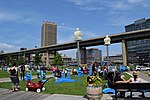M. Wile and Company Factory Building

M. Wile and Company Factory Building is a historic garment factory located at Buffalo in Erie County, New York. It is an early and significant example of the "Daylight Factory." The four story building erected in 1924, is constructed of reinforced concrete and features curtain walls of metal sash windows. It was home to M. Wile & Company until 1999; a major manufacturer of men's suits founded by Mayer Wile in Buffalo in 1877. In 1969, the company became a subsidiary of Hartmarx.In 2007, plans were announced for redevelopment of the historic factory building as part of the Buffalo Niagara Medical Campus. The first floor of the building is occupied by the Buffalo Employment and Training Center.It was listed on the National Register of Historic Places in 2000.
Excerpt from the Wikipedia article M. Wile and Company Factory Building (License: CC BY-SA 3.0, Authors, Images).M. Wile and Company Factory Building
Goodell Street, Buffalo
Geographical coordinates (GPS) Address Nearby Places Show on map
Geographical coordinates (GPS)
| Latitude | Longitude |
|---|---|
| N 42.894444444444 ° | E -78.868611111111 ° |
Address
Goodell Street 77
14203 Buffalo
New York, United States
Open on Google Maps











